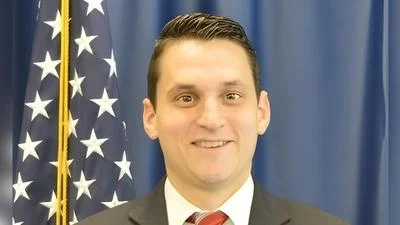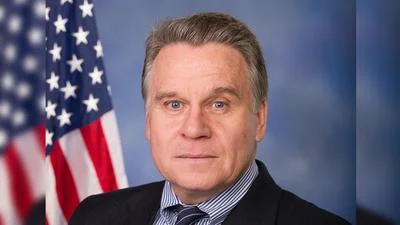Border county Sheriff William Chadborn of Hidalgo County, New Mexico has noted the multifaceted challenges facing law enforcement in a border region fraught with complex issues, from drug trafficking to managing the human costs of illegal crossings.
Following the mass illegal immigration of around 10.5-13 million undocumented aliens in the United States over the past few years, Chadborn underscored the need for a comprehensive approach to border security and the humanitarian aspects of policing such a volatile area marked by its proximity to both Mexico and Arizona.
Chadborn, who assumed office in early 2022 after a 16-year career with the New Mexico State Police and three years with the Lordsburg City Police, has witnessed, firsthand, the complexities of border enforcement.
"I've been sheriff for a year and a half now," Chadborn told Federal Newswire. "We border Mexico and Arizona, and the challenges are as vast as our landscape."
Chadborn said cartels are active in his jurisdiction every day.
Hidalgo County, situated in New Mexico's bootheel, is the state's southernmost county with a population of 4,178.
Most of the county is sparsely populated with scattered farms and ranches, averaging fewer than one person per square mile.
It shares an 86-mile border with Mexico making it a prime target for cartel smugglers given its easy access from Interstate 10.
Hidalgo County’s five border Mexico crossings are crucial for the U.S. import of fresh produce from Mexico.
In 2020, these ports facilitated the entry of $4.5 billion worth of fruits and vegetables into Texas.
But it is often the unseen cargo making its way through the border at Hidalgo County that has the largest impact.
"We know that there's stuff that is still coming through, but it's in vehicles. It's coming from either Arizona or another county to our east in vehicles and going through Lordsburg," he said.
Drugs found in stopped and searched vehicles in the area often include methamphetamine and fentanyl.
"Meth seems to be what we're finding in these cars that are coming through, and right across the road on I-10, State Police at their checkpoint for semis got a pretty good-sized load not too long ago of fentanyl," he said.
Chadborn described the local impact of these drugs and the challenges they present.
"We are still seeing fentanyl in town and there are still people using it. Meth is, I don't want to say a huge issue, but the people that are using it are using it a lot. So we know it's here," he said.
Mexican criminal groups have diversified beyond drug trafficking into extortion, people smuggling and more.
Politico recently called the situation at the border a “national security threat” and warned that the growing power of these cartels poses a severe challenge to regional stability and requires urgent, coordinated action from both nations.
The El Paso Sector, which includes Hidalgo County, has seen a significant increase in smuggling activities, with Border Patrol agents frequently intercepting attempts to bypass checkpoints.
In recent years, Hidalgo County has become a hotspot for human smuggling.
In an interview with the Daily Mail, Chadborn described the town of Lordsburg as a "paradise" for traffickers, citing difficulties enforcing the law under the Safe Pursuit Act, which limits police chases.
Since 2021, illegal crossings have surged, with smugglers using the town as a drop-off point for migrants who are then transported further into the U.S.
Smugglers often pick up cars waiting for them in Hidalgo County once they cross the border.
Chadborn stressed the ongoing danger posed by drivers involved in smuggling operations.
“The car stuff, they just refuse to stop and they always speed up – as soon as you turn on the lights, they always speed up,” he said.
Chadborn outlined the difficulties law enforcement faces in addressing high-speed chases involving smuggling suspects whose only goal is to speed through the county as fast as possible until they make it to the next jurisdiction.
"It's been a challenge. We don’t want to put 5 or 8 people at risk by doing a PIT maneuver at a high rate of speed,” he said. “Anything over 35 miles an hour is considered deadly force, and we don’t have the elements to use deadly force unless it's absolutely necessary."
In the past, he said - sometimes - as many as five so-called “cartel cars” roared through Hidalgo County in one day.
"The honest, hardworking, everyday person is not going to fall prey to this fast money that the cartels are offering,” he said. “But these kids, they're just driven by the thrill and they don’t have any regard for anything but themselves."
The reckless driving has resulted in deaths as well.
Last year, 71-year-old Maria Tambunga and seven-year-old Emilia Tambunga were killed after a smuggler ran into their vehicle. In that instance, the illegal immigrant, driving the vehicle, was videoing himself driving in excess of 100 miles per hour when he slammed into the Tambungas who were stopped at a red light.
The sheriff expressed frustration with the lack of federal action on immigration and border issues.
"I think I'd like to see them get serious about it and quit blaming each other in Washington,” he said. “It's aggravating to most people I know, regardless of race or background. It's frustrating for everyone, especially for those who have done things the right way."
Chadborn voiced concerns over the allocation of resources and the impact on border security.
He added that manpower shortages and shifting responsibilities at Border Patrol have also contributed to enforcement challenges.
"I just don’t understand why they can't hire civilian personnel to process these people,” he said. “Instead, they take an agent that’s making roughly $100,000 a year and put them in an office somewhere typing names on a piece of paper. It seems to me that if they could hire civilians for this, it would put those agents back where they’re needed most."





